Effect of Transition Layer on Properties of Tungsten-Tantalum (W-Ta) Laminated Composite
Abstract
:1. Introduction
2. Experiment
2.1. Preparation of Samples
2.2. Tensile Tests
2.3. Three-Point Bending Tests
3. Results and Discussion
3.1. Tensile Test Results and Fracture Morphology
3.2. Three-Point Bending Test Results and Crack Distribution
3.3. The Effect of Element Diffusion
3.4. Elastic Modulus of W-Ta Laminated Composites
4. Conclusions
Author Contributions
Funding
Acknowledgments
Conflicts of Interest
References
- Zinkle, S.J.; Möslang, A.; Muroga, T.; Tanigawa, H. Multimodal options for materials research to advance the basis for fusion energy in the ITER era. Nucl. Fusion 2013, 53, 104024. [Google Scholar] [CrossRef]
- Wurster, S.; Baluc, N.; Battabyal, M.; Crosby, T.; Du, J.; García, T.P.; Hasegawa, A.; Hoffmann, A.; Kimura, A.; Kurishita, H.; et al. Recent progress in R&D on tungsten alloys for divertor structural and plasma facing materials. J. Nucl. Mater. 2013, 442, S181–S189. [Google Scholar] [CrossRef] [Green Version]
- Iveković, A.; Omidvari, N.; Vrancken, B.; Lietaert, K.; Thijs, L.; Vanmeensel, K.; Vleugels, J.; Kruth, J.-P. Selective laser melting of tungsten and tungsten alloys. Int. J. Refract. Met. Hard Mater. 2018, 72, 27–32. [Google Scholar] [CrossRef]
- Lassner, E.; Schubert, W.-D. Tungsten; Kluwer Academic/Plenum Publishers: New York, NY, USA, 1999. [Google Scholar]
- Ren, C.; Fang, Z.Z.; Koopman, M.; Butler, B.; Paramore, J.; Middlemas, S. Methods for improving ductility of tungsten-A review. Int. J. Refract. Met. Hard Mater. 2018, 75, 170–183. [Google Scholar] [CrossRef]
- Li, H.; Wurster, S.; Motz, C.; Romaner, L.; Ambrosch-Draxl, C.; Pippan, R. Dislocation-core symmetry and slip planes in tungsten alloys: Ab initio calculations and micro cantilever bending experiments. Acta Mater. 2020, 60, 748–758. [Google Scholar] [CrossRef]
- Hirsch, P. Comment. In Proceedings of the 5th International Conference on Crystallography & Novel Materials, Helsinki, Finland, 25–26 November 2019; Cambridge University: Cambridge, UK, 1960; p. 139. [Google Scholar]
- Groger, A.; Vitek, V. Multiscale modeling of plastic deformation of molybdenum and tungsten: I. Atomistic studies of the core structure and glide of 1/2 <1 1 1> screw dislocations at 0 K. Acta Mater. 2008, 56, 5401–5411. [Google Scholar] [CrossRef]
- Bonk, S.; Reiser, J.; Hoffmann, J.; Hoffmann, A. Cold rolled tungsten (W) plates and foils: Evolution of the microstructure. Int. J. Refract. Met. Hard Mater. 2016, 60, 92–98. [Google Scholar] [CrossRef]
- Geach, G.; Hughes, J. The Alloys of Rhenium with Molybdenum or with Tungsten and Having Good High Temperature Properties, Plansee Proceedings 1955, Sintered High-temperature and Corrosion-resistant Materials. In Proceedings of the Second Plansee Seminar, Reutte, Austria, 19–23 June 1955; pp. 245–253. [Google Scholar]
- Wurster, S.; Gludovatz, B.; Hoffmann, A.; Pippan, R. Fracture behavior of tungsten-vanadium and tungsten-tantalum alloys and composites. J. Nucl. Mater. 2011, 413, 166–176. [Google Scholar] [CrossRef]
- Rieth, M.; Reister, J.; Dafferner, B.; Baumgärtner, S. Michael Rieth Karlsruhe Institute of Technology Institute for Applied Materials P.O. Box Karlsruhe Germany The Impact of Refractory Material Properties on the Helium Cooled Divertor Design. Fusion Sci. Technol. 2012, 61, 381–384. [Google Scholar] [CrossRef]
- Aguirre, M.V.; Martin, A.; Pastor, J.Y.; Llorca, J.; Monge, M.; Pareja, R. Mechanical Behavior of W-Y2O3 and W-Ti Alloys from 25 °C to 1000 °C. Met. Mater. Trans. A 2009, 40, 2283–2290. [Google Scholar] [CrossRef]
- Yan, Q.; Zhang, X.; Wang, T.; Yang, C.; Ge, C. Effect of hot working process on the mechanical properties of tungsten materials. J. Nucl. Mater. 2013, 442, S233–S236. [Google Scholar] [CrossRef]
- Battabyal, M.; Schäublin, R.; Spätig, P.; Baluc, N. W–2wt.%Y2O3 composite: Microstructure and mechanical properties. Mater. Sci. Eng. A 2012, 538, 53–57. [Google Scholar] [CrossRef]
- Kurishita, H.; Arakawa, H.; Matsuo, S.; Sakamoto, T.; Kobayashi, S.; Nakai, K.; Pintsuk, G.; Linke, J.; Tsurekawa, S.; Yardley, V.; et al. Development of Nanostructured Tungsten Based Materials Resistant to Recrystallization and/or Radiation Induced Embrittlement. Mater. Trans. 2013, 54, 456–465. [Google Scholar] [CrossRef] [Green Version]
- Wei, Q.; Jiao, T.; Ramesh, K.T.; Ma, E.; Kecskes, L.; Magness, L.; Dowding, R.; Kazykhanov, V.; Valiev, R. Mechanical behavior and dynamic failure of high-strength ultrafine grained tungsten under uniaxial compression. Acta Mater. 2005, 54, 77–87. [Google Scholar] [CrossRef]
- Shen, T.; Dai, Y.; Lee, Y. Microstructure and tensile properties of tungsten at elevated temperatures. J. Nucl. Mater. 2016, 468, 348–354. [Google Scholar] [CrossRef]
- Faleschini, M.; Kreuzer, H.; Kiener, D.; Pippan, R. Fracture toughness investigations of tungsten alloys and SPD tungsten alloys. J. Nucl. Mater. 2007, 367, 800–805. [Google Scholar] [CrossRef]
- Reiser, J.; Rieth, M.; Dafferner, B.; Hoffmann, A.; Yi, X.; Armstrong, D.E.J. Tungsten foil laminate for structural divertor applications-Analyses and characterisation of tungsten foil. J. Nucl. Mater. 2012, 424, 197–203. [Google Scholar] [CrossRef]
- Reiser, J.; Garrison, L.; Greuner, H.; Hoffmann, J.; Weingärtner, T.; Jäntsch, U.; Klimenkov, M.; Franke, P.; Bonk, S.; Bonnekoh, C.; et al. Ductilisation of tungsten (W): Tungsten laminated composites. Int. J. Refract. Met. Hard Mater. 2017, 69, 66–109. [Google Scholar] [CrossRef]
- Terentyev, D.; Xiao, X.; Dubinko, A.; Bakaeva, A.; Duan, H. Dislocation-mediated strain hardening in tungsten: Thermo-mechanical plasticity theory and experimental validation. J. Mech. Phys. Solids 2015, 85, 1–15. [Google Scholar] [CrossRef]
- Du, J.; You, J.H.; Hoschen, T. Thermal stability of the engineered interfaces in W-f/W composites. J. Mater. Sci. 2012, 47, 4706–4715. [Google Scholar] [CrossRef]
- Reiser, J.; Franke, P.; Weingärtner, T.; Hoffmann, J.; Hoffmann, A.; Rieth, M. Tungsten laminates made of ultrafine-grained (UFG) tungsten foil—Ageing of tungsten–titanium (W–Ti) laminates. Int. J. Refract. Met. Hard Mater. 2015, 51, 264–274. [Google Scholar] [CrossRef]
- Reiser, J.; Rieth, M.; Moslang, A.; Dafferner, B.; Hoffmann, J.; Mrotzek, T.; Hoffmann, A.; Armstrong, D.E.J.; Yi, X. Tungsten foil laminate for structural divertor applications—Joining of tungsten foils. J. Nucl. Mater. 2013, 5, 47–55. [Google Scholar] [CrossRef]
- Zhang, Y.; Ouyang, T.; Liu, D.; Wang, Y.; Du, J.; Zhang, C.; Feng, S.; Suo, J. Effect of thickness ratio on toughening mechanisms of Ta/W multilayers. J. Alloys Compd. 2016, 666, 30–37. [Google Scholar] [CrossRef]
- Zhang, Y.; Xu, G.; Wang, Y.; Zhang, C.; Feng, S.; Suo, J. Mechanical properties study of W/TiN/Ta system multilayers. J. Alloys Compd. 2017, 725, 283–290. [Google Scholar] [CrossRef]
- Wang, H.; Li, Q. Prediction of elastic modulus and Poisson’s ratio for unsaturated concrete. Solids Struct 2007, 44, 1370–1379. [Google Scholar] [CrossRef] [Green Version]
- Vogit, W. Ueber die Beziehung zwischen den beiden Elasticitätsconstanten isotroper Körper. Annalen Physik 1889, 274, 573–587. [Google Scholar] [CrossRef] [Green Version]
- Liu, P.; Wan, Z. Modified method for the prediction of effective elastic modulus of composite materials. J. Yangzhou Univ. Nat. Sci. Ed. 2007, 10, 1. [Google Scholar]
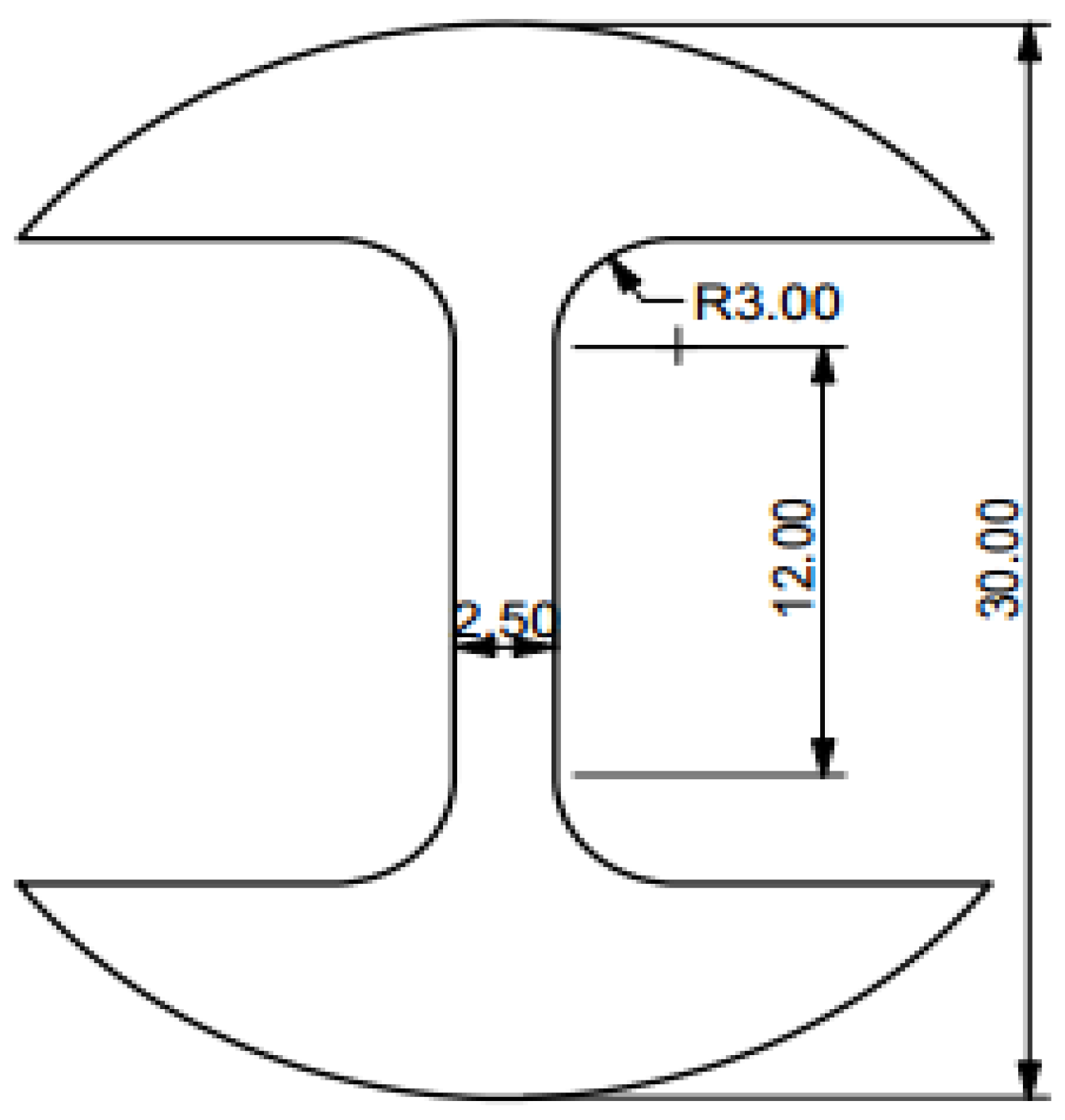

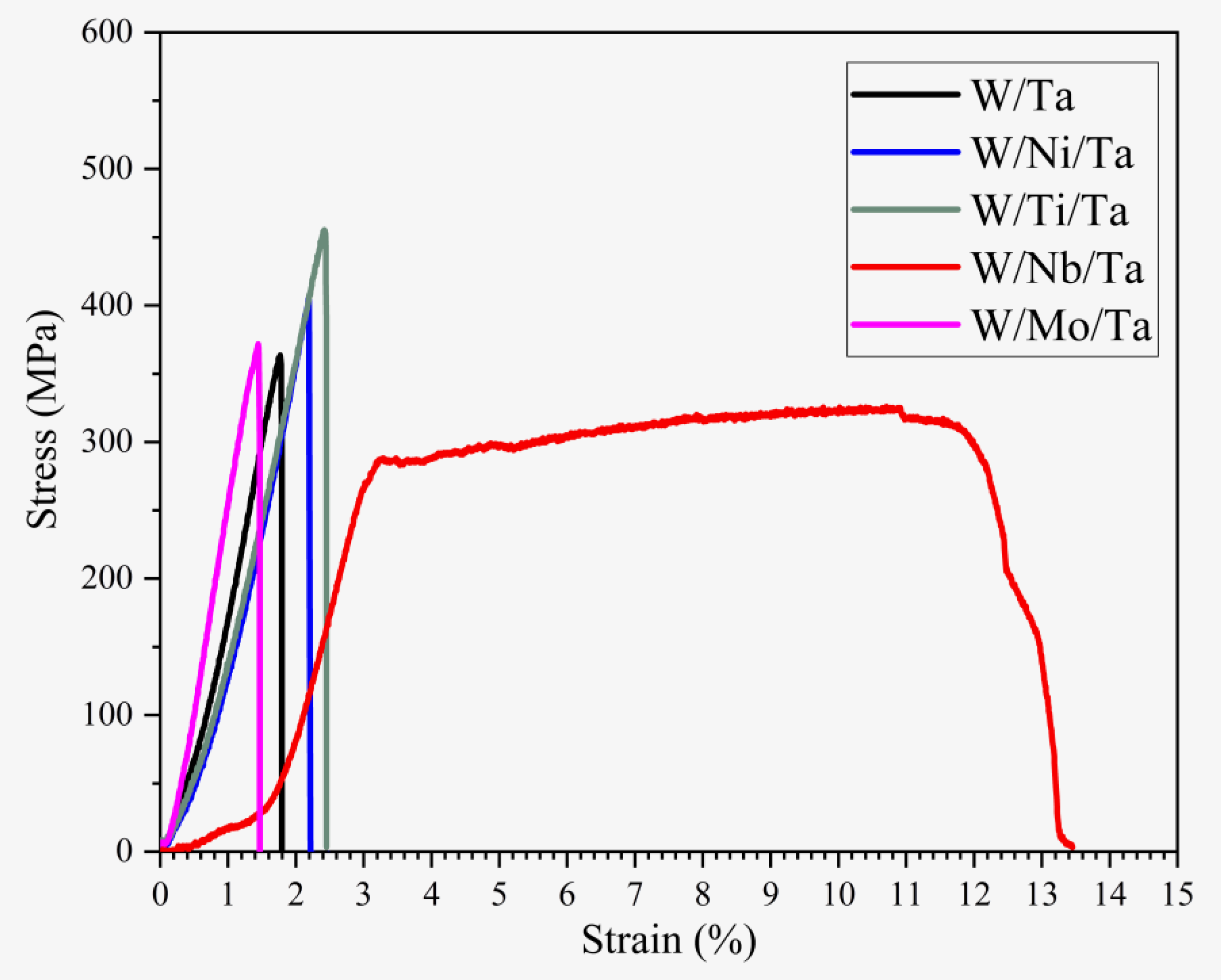

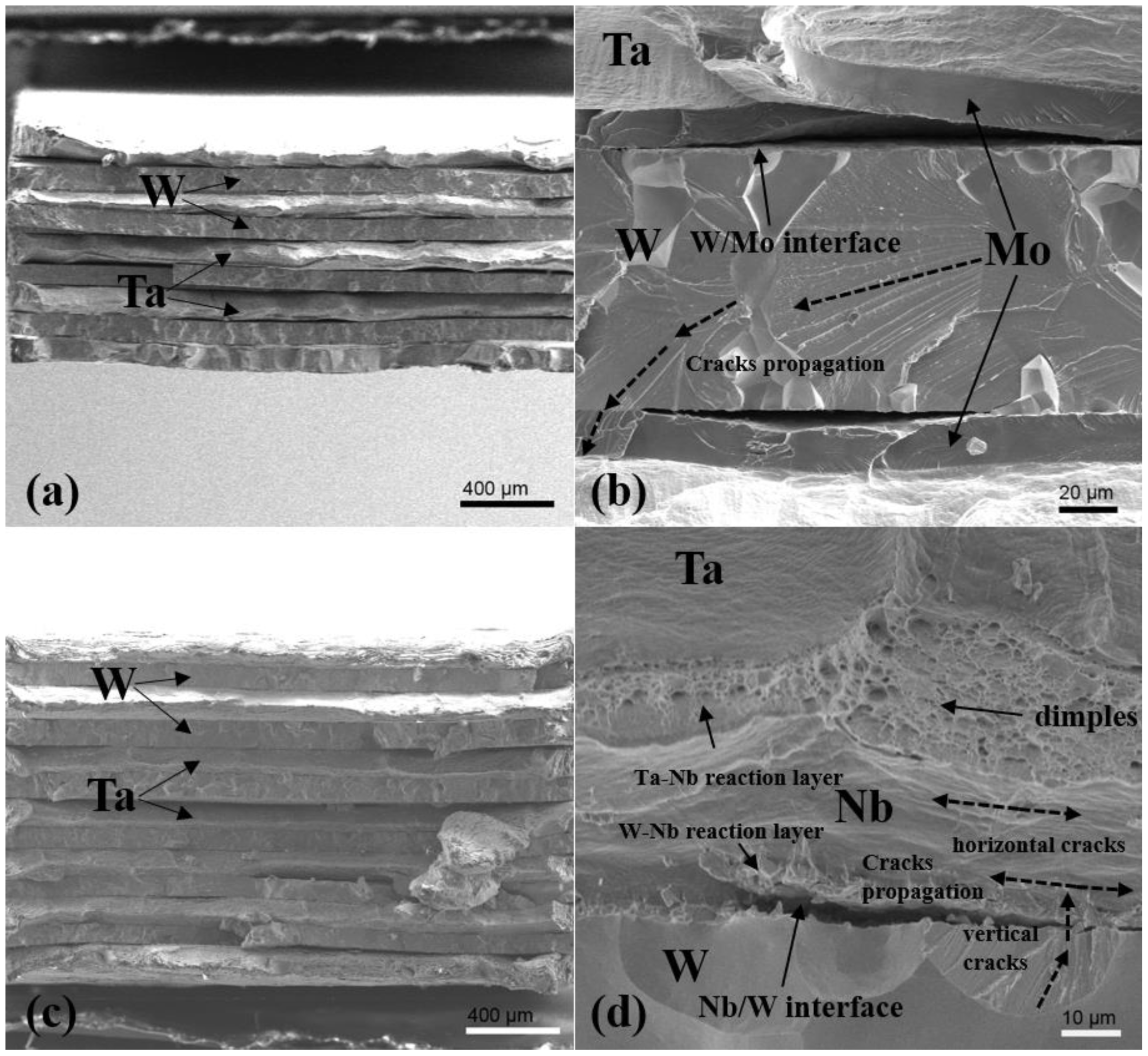
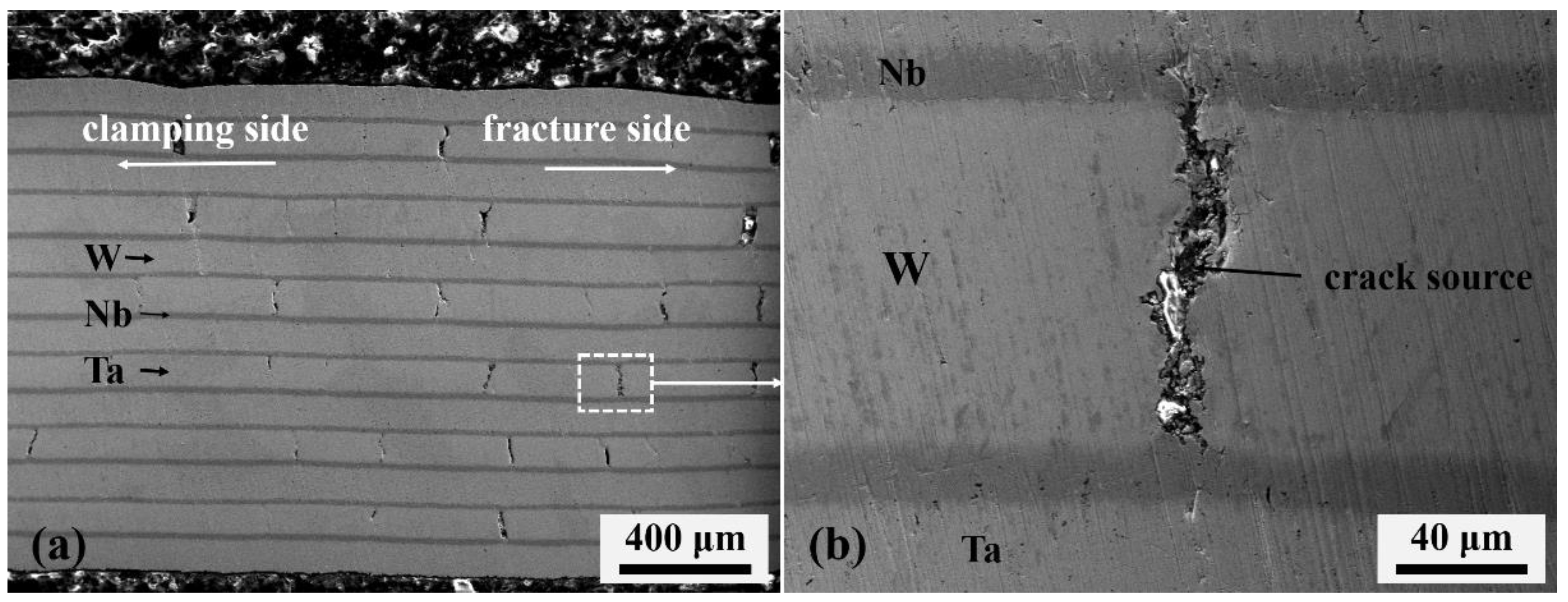
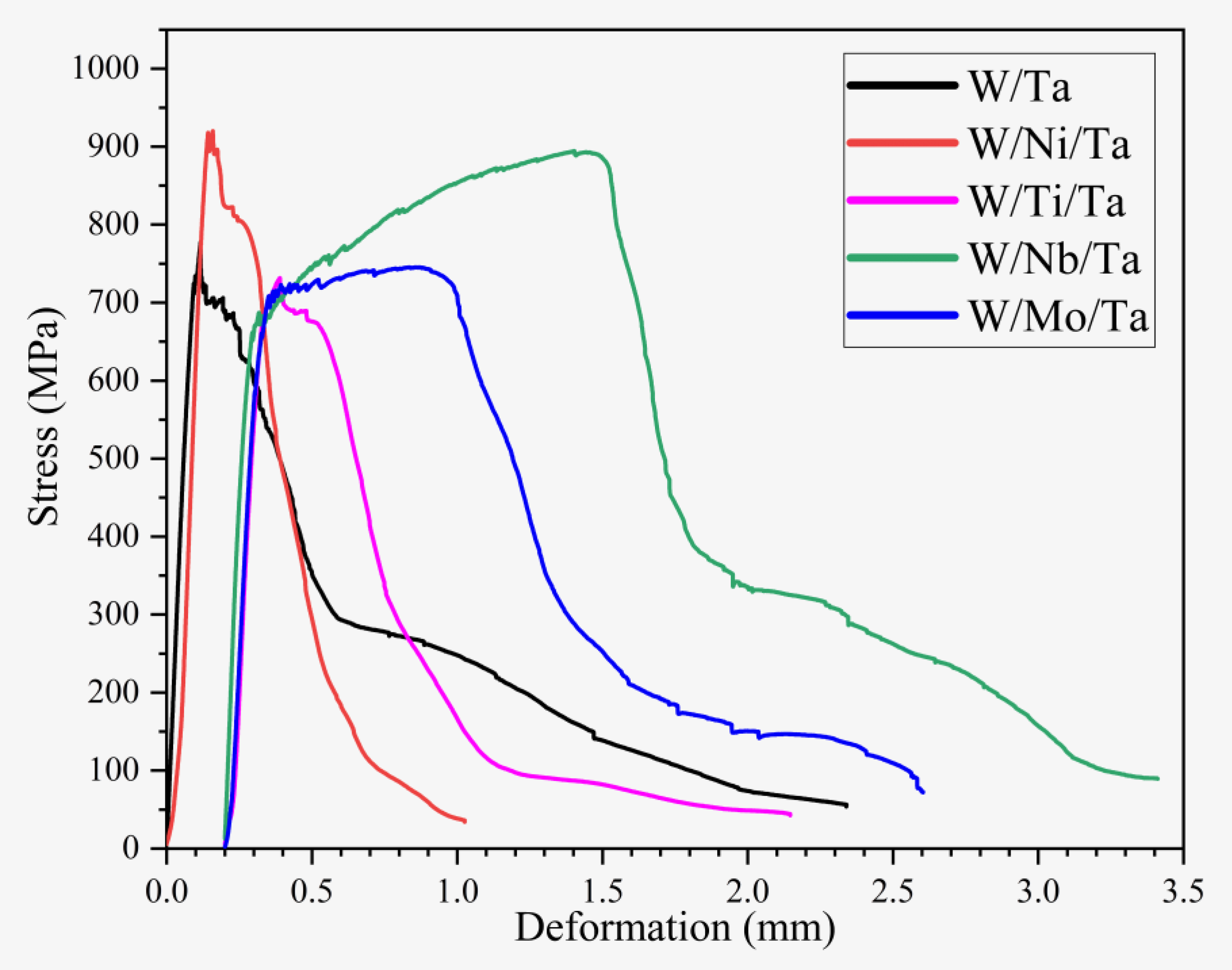



| Materials | Thickness | Purity | Melt Point |
|---|---|---|---|
| W | 100 µm | 99.95% | 3422 °C |
| Ta | 100 µm | 99.95% | 3017 °C |
| Ni | 10 µm | 99.99% | 1453 °C |
| Ti | 10 µm | 99.99% | 1668 °C |
| Nb | 25 µm | 99.99% | 2469 °C |
| Mo | 15 µm | 99.99% | 2620 °C |
| Composites | SPS Temperature | Pressure | Holding Time |
|---|---|---|---|
| W/Ta | 1700 °C | 60 MPa | 10 min |
| W/Ni/Ta | 1000 °C | 60 MPa | 10 min |
| W/Ti/Ta | 1200 °C | 60 MPa | 10 min |
| W/Nb/Ta | 1500 °C | 60 MPa | 10 min |
| W/Mo/Ta | 1500 °C | 60 MPa | 10 min |
| Composites | Strength (MPa) | Elongation (%) | Integral (MPa·%) |
|---|---|---|---|
| W/Ta | 363 | 1.8 | 288 |
| W/Ni/Ta | 405 | 2.2 | 366 |
| W/Ti/Ta | 455 | 2.4 | 489 |
| W/Mo/Ta | 372 | 1.4 | 258 |
| W/Nb/Ta | 326 | 13 | 3236 |
| Metals | Young Modulus (GPa) | Poisson’s Ratio: ν | Shear Modulus (GPa) |
|---|---|---|---|
| W | 406 | 0.28 | 159 |
| Ta | 186 | 0.35 | 69 |
| Ni | 214 | 0.31 | 82 |
| Ti | 114 | 0.35 | 42 |
| Nb | 105 | 0.35 | 39 |
| Mo | 329 | 0.31 | 126 |
| Composite | Volume Fraction | Voigt Prediction | Experimental | ||||
|---|---|---|---|---|---|---|---|
| Eeff (GPa) | Deviation (%) | Geff (GPa) | Deviation (%) | Eexp (GPa) | Gexp (GPa) | ||
| W/Ta | W:0.467, Ta:0.533 | 289 | +9.1 | 111 | −18.9 | 265 | 137 |
| W/Ni/Ta | W:0.423, Ta:0.493, Ni:0.084 | 281 | +28.3 | 108 | −29.4 | 219 | 153 |
| W/Ti/Ta | W:0.423, Ta:0.493, Ni:0.084 | 273 | +13.8 | 104 | −5.4 | 240 | 110 |
| W/Nb/Ta | W:0.371, Ta:0.444, Nb:0.185 | 253 | −6.6 | 97 | −18.5 | 271 | 119 |
| W/Mo/Ta | W:0.405, Ta:0.473, Mo:0.122 | 293 | −7.0 | 112 | +1.8 | 315 | 110 |
© 2020 by the authors. Licensee MDPI, Basel, Switzerland. This article is an open access article distributed under the terms and conditions of the Creative Commons Attribution (CC BY) license (http://creativecommons.org/licenses/by/4.0/).
Share and Cite
Yan, Z.; Xu, G.; Suo, J. Effect of Transition Layer on Properties of Tungsten-Tantalum (W-Ta) Laminated Composite. Metals 2020, 10, 558. https://doi.org/10.3390/met10050558
Yan Z, Xu G, Suo J. Effect of Transition Layer on Properties of Tungsten-Tantalum (W-Ta) Laminated Composite. Metals. 2020; 10(5):558. https://doi.org/10.3390/met10050558
Chicago/Turabian StyleYan, Zizhi, Gaoyong Xu, and Jinping Suo. 2020. "Effect of Transition Layer on Properties of Tungsten-Tantalum (W-Ta) Laminated Composite" Metals 10, no. 5: 558. https://doi.org/10.3390/met10050558





